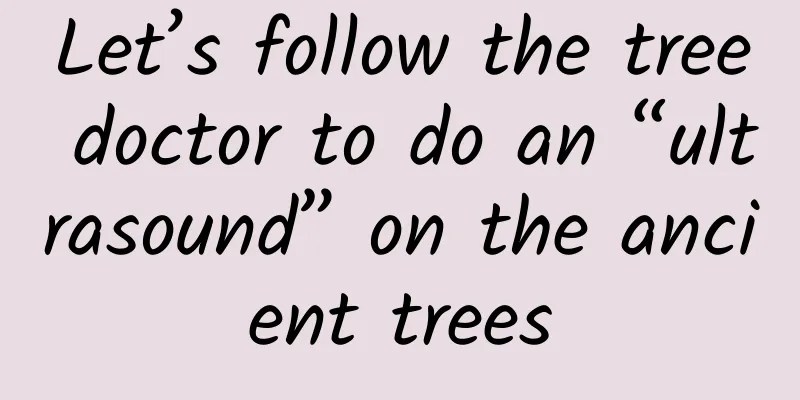Let’s follow the tree doctor to do an “ultrasound” on the ancient trees

|
B-ultrasound is an important detection technology in modern medicine. The principle of B-ultrasound is to use ultrasonic waves (sound waves with a frequency of more than 20,000 Hz, which we humans cannot hear!) to penetrate objects and propagate in a certain direction. If ultrasonic waves encounter obstacles, they will produce echoes. Different types of obstacles will produce different echoes. People collect these echoes through instruments and display them on the screen to understand the internal structure of the human body. Many old trees look like they have intact barks and are well-dressed, but their hearts are empty. How can we understand the internal conditions of old trees without harming them? People have tried many methods, but they are difficult to promote because the equipment is too expensive or the operation procedures are too complicated. With the unremitting efforts of scientists and engineers, a B-ultrasound device for trees was successfully developed in 2007 - a tree non-destructive testing instrument, which allows us to get a glimpse of the internal conditions of trees through simple operations. The principle of a tree non-destructive testing instrument is basically the same as that of a B-ultrasound instrument, which uses the different propagation rates of stress waves in different materials to test and inspect wood. Dear readers, are you ready? Let's follow the tree doctor to do B-ultrasound on the ancient tree! The tree non-destructive testing equipment is very simple, including a laptop, a tool box and a tree defect imaging software. The overall weight of the equipment is about 8kg, and an adult can easily carry it, which is very convenient! First, the tree doctor will fix the sensor on the ancient tree. The sensor should be installed on the same level. The sensor, power cord box and laptop are connected to each other through the connecting cable, and then the system analysis software is activated. The location of each sensor and other data will be input through the analysis software. All preparations are ready! Next is the much-anticipated measurement phase. The tree doctor used a hammer to gently hit each sensor three times in a counterclockwise direction. Every time the "dong" sound was hit, the system software in the computer would emit a crisp "ding" echo. This echo is the sensor's determination of the propagation rate of sound between each measurement point. These rate data will be compared with each other according to certain standards to form stress wave propagation data. We looked at these data for a long time and still felt confused. Don't worry, don't worry. When all the sensors were hit, the tree doctor clicked the "imaging" button in the software, and the laptop computer would display the analysis results in image mode. The analysis program would represent the different acoustic conduction characteristics of the cross section of the ancient tree trunk in different colors, that is, dark colors (green and brown) represent high acoustic conduction velocity areas - that is, healthy wood, and other colors (red, purple, blue to light blue) represent low acoustic conduction velocity areas - that is, damaged wood or air. The detector detects the ratio between the rotten area and the total area in the fault cross section. The larger the ratio, the higher the degree of decay of the cross section of the ancient tree trunk. How about it? With the tree non-destructive testing instrument, we can easily handle the detection of tree holes in ancient trees, allowing you to be a real tree doctor! About the author: Xie Xinggang, male, currently works at Taiyuan Garden Science and Technology Service Center as the section chief of the Tree Research Laboratory and a senior engineer. He is engaged in the protection and rejuvenation of ancient and famous trees and scientific research and development. |
<<: Mistaking cancer for a cold, a 95-year-old patient regrets fatal negligence
>>: It is green, but why is it so hard to see trees on the grassland?
Recommend
What does depression do to the brain?
This article was reviewed by Zhao Wei, deputy chi...
Insect repellent
Can Cordyceps be placed in the bedroom? Cordyceps...
The efficacy and function of silkworm paper
Traditional Chinese medicine has always been the ...
How about the Chinese medicine Bamboo Leaf Green?
Bamboo Leaf Green Tea can not only be made into a...
What are the benefits of natural wild Ganoderma lucidum?
There are many precious Chinese medicinal materia...
What exactly is the "Hongyan Constellation"? How is it different from the "Beidou"?
Everyone knows that you need to turn off your pho...
Cool Facts | What determines the thickness of poop?
Appendix: 1. What is a healthy bowel movement? Wh...
Who is healthier, people who like to add vinegar to their meals or those who don’t? The truth is surprising
When you open the spice cabinet in the kitchen, t...
The efficacy and function of red stone ear
Do you know red fungus? It is a common Chinese me...
What effects can be achieved by drinking ginseng in water?
I believe that in daily life many women will have...
Which is bigger, 9/11 or 9/9? A question that a kindergarten kid can answer stumps a bunch of AIs…
Which one is bigger, 9.11 or 9.9? This question, ...
What are the effects and functions of Amomum villosum powder?
Many friends should have some knowledge of Amomum...
The efficacy and function of birch bark
Birch bark is commonly used as a medicinal ingred...
Traditional Chinese medicine formula for removing spots, yellowing and whitening
Removing freckles and whitening the skin is somet...









